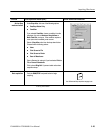
Acquiring Waveforms
CSA8000B & TDS8000B User Manual
3-29
Sample interval
First sampled and
digitized point
Horizontal delay
Recurring trigger events
fromtrigger signal
Waveformrecord acquired
over many acquisitions,
1 sample peracquisition
Record length
Figure 3- 9: The waveform record and its defining parameters
As Figure 3--9 shows, the instrument acquires points in order from left to right,
with each point from a separate trigger event, and delayed from that event by:
horizontal delay + (sample interval x (sample number -- 1))
When all the points in the waveform record have been sampled and digitized, the
waveform record is in acquisition memory and becomes available for display (or
use in math waveforms, storing, exporting, and elsewhere). See Acquisition
Cycle, which follows.
For a control-oriented discussion of the waveform record, see:
H Horizontal Acquisition Window Considerations on page 3--17.
H Horizontal Scale vs. Record Length vs. Sample Interval vs. Resolution on
page 3--19.
The process of building a record is a subpart the acquisition cycle, which
describes how the instrument cycles through recognizing a trigger, taking a
sample and processing it according to sample mode, and adding it to a waveform
record. This manual describes the normal acquisition cycle in Process Overview
Map on page 2--6. Note the following points regarding acquisition cycles:
H A waveform record exists, either on display or as an icon on the waveform
bar , until it is replaced by a more recent acquisition or until you clear the
record. The process of clearing waveform records is described on page 3--26.
H Choose the FrameScan cycle when you want to test for anomalies in
Pseudo-Random Bit Streams. See FrameScan Acquisitions on page 3--30.
Acquisition Cycle


















